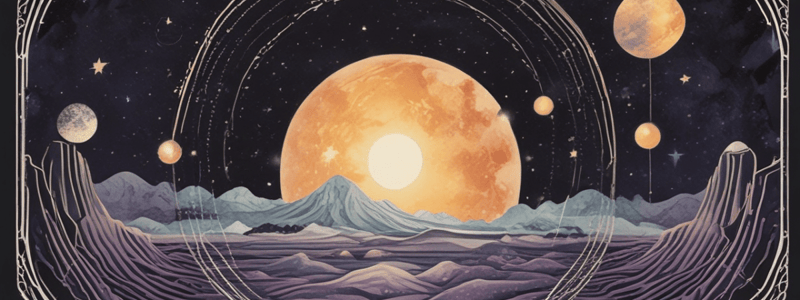Podcast
Questions and Answers
What is the stage of a star's life cycle where it fuses hydrogen into helium in its core?
What is the stage of a star's life cycle where it fuses hydrogen into helium in its core?
- Star birth
- Main sequence star (correct)
- Star death
- Red giant star
Which of the following factors determines a star's characteristics, such as color, size, and lifespan?
Which of the following factors determines a star's characteristics, such as color, size, and lifespan?
- Surface temperature
- Mass of the star (correct)
- Distance from Earth
- Core temperature
What is the color of a star with a surface temperature of 40,000°C?
What is the color of a star with a surface temperature of 40,000°C?
- Red
- Blue (correct)
- Green
- Yellow
Which type of star has a lifespan of up to 100 billion years?
Which type of star has a lifespan of up to 100 billion years?
Why do massive stars have shorter lifespans than smaller stars?
Why do massive stars have shorter lifespans than smaller stars?
What happens to the star's core when the hydrogen is depleted?
What happens to the star's core when the hydrogen is depleted?
What is a characteristic of a red giant star?
What is a characteristic of a red giant star?
What type of fusion begins in the core of a red giant star?
What type of fusion begins in the core of a red giant star?
What happens to the star after the red giant phase if it is a star like the Sun?
What happens to the star after the red giant phase if it is a star like the Sun?
What elements are produced in the core of a red giant star?
What elements are produced in the core of a red giant star?
What is the primary factor that determines the length of a star's main sequence stage?
What is the primary factor that determines the length of a star's main sequence stage?
What is the relationship between the surface temperature of a star and its color?
What is the relationship between the surface temperature of a star and its color?
Which of the following statements about main sequence stars is true?
Which of the following statements about main sequence stars is true?
What is the fate of a star with 10 times the mass of the Sun?
What is the fate of a star with 10 times the mass of the Sun?
What is a characteristic of a star that is 'born'?
What is a characteristic of a star that is 'born'?
What is the result of the core contraction in a star transitioning to a red giant?
What is the result of the core contraction in a star transitioning to a red giant?
What is the significance of the core temperature in a red giant star?
What is the significance of the core temperature in a red giant star?
What happens to a star like the Sun after the red giant phase?
What happens to a star like the Sun after the red giant phase?
What is a characteristic of a star in the red giant phase?
What is a characteristic of a star in the red giant phase?
What is the fate of a star like the Sun due to its inability to fuse carbon and oxygen?
What is the fate of a star like the Sun due to its inability to fuse carbon and oxygen?
Which of the following factors is responsible for the observable characteristics of a star?
Which of the following factors is responsible for the observable characteristics of a star?
What determines the length of a star's lifespan on the main sequence?
What determines the length of a star's lifespan on the main sequence?
What is the primary difference between a massive star and a red dwarf?
What is the primary difference between a massive star and a red dwarf?
What is the consequence of a star consuming its nuclear fuel more rapidly?
What is the consequence of a star consuming its nuclear fuel more rapidly?
What is the relationship between the surface temperature and color of a main sequence star?
What is the relationship between the surface temperature and color of a main sequence star?
What is the primary reason for the star's outer layers to expand during the transition to a red giant?
What is the primary reason for the star's outer layers to expand during the transition to a red giant?
What is the significance of helium fusion in the core of a red giant star?
What is the significance of helium fusion in the core of a red giant star?
What determines the fate of a star after the red giant phase, according to its mass?
What determines the fate of a star after the red giant phase, according to its mass?
What is the outcome of the star's evolution after the helium in the core is exhausted, for stars like the Sun?
What is the outcome of the star's evolution after the helium in the core is exhausted, for stars like the Sun?
What is the relationship between the star's brightness and its size during the red giant phase?
What is the relationship between the star's brightness and its size during the red giant phase?




